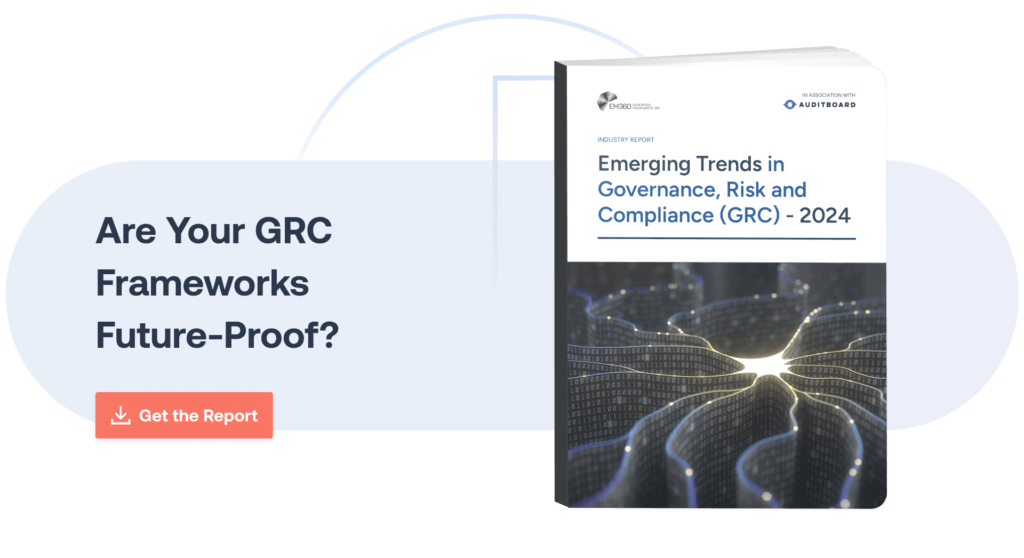
September 12, 2024 • 15 min read
The New Frontier of AI in GRC: The Good, the Bad… the Future
It’s a transformative time for governance, risk, and compliance (GRC) professionals. Recent advancements like generative AI have brought great benefits and challenges. As technology and business practices advance, GRC leaders must be equipped with the tools to mitigate current compliance needs and prepare for future risks.
Read on for an excerpt on AI in GRC from AuditBoard and EM360’s Emerging Trends in Governance, Risk and Compliance, and download the full report for a deeper dive into the how GRC leaders are working to ensure safe, ethical, and financially responsible outcomes in an evolving regulatory environment.
The New Frontier: AI in GRC – The Good, the Bad… the Future
In the last decade, the emergence of artificial intelligence, particularly generative AI that can craft entirely original content with just instructions, has been the most significant technological leap. The coming years, including 2024, will be defined by how corporations can leverage AI for responsible and profitable gains.
The compliance department bears the responsibility of anticipating the potential challenges and threats that AI presents. For instance, AI could be harnessed by compliance teams themselves to optimize or solidify their function. Other departments within the organization could also discover ways to incorporate AI productively into their operations. However, there’s also the risk of departments rushing forward without proper consideration, potentially creating a multitude of compliance and cybersecurity issues.
According to a survey by Deloitte, 62% of organizations have reported that AI has significantly helped them improve the efficiency of their compliance procedures. This enhancement is largely due to AI’s ability to automate complex and repetitive tasks, such as compliance audits and risk assessments.
Therefore, as compliance officers start to employ AI tools within their own areas of expertise, they must also serve as trusted advisors to senior management and other departments. This dual role ensures that AI implementation across the company is conducted prudently and with a keen awareness of risks, while strictly adhering to legal standards. This approach not only mitigates potential pitfalls but also maximizes the technology’s benefits in a controlled and compliant manner.
The Double-Edged Sword of Generative AI
Generative AI, the technology behind tools like ChatGPT (which boasted over 180 million users in early 2024), boasts immense potential. By leveraging Natural Language Processing (NLP), it allows users to interact with AI in plain language, just like talking to a colleague. Imagine a vast data lake at your fingertips, readily responding to employee queries. Enterprises are already exploring its use for tasks like content creation, chatbot development, and even marketing copywriting.
Unlocking Efficiency: Businesses can leverage an NLP interface to empower employees. Imagine a marketing team asking: “What social media content themes resonate most with our target demographic?” or a sales team querying: “Which existing customers are most likely to benefit from our new product launch?” A recent McKinsey study found that up to 80% of an employee’s time can be spent on tasks automatable with AI, highlighting the potential for significant efficiency gains.
However, this power comes with inherent risks. Without proper safeguards, AI accuracy suffers. The data it consumes, potentially including confidential information, could be used to refine future responses for other users. Unforeseen interactions with employees and customers could arise. Flawed training data can lead the AI to adopt “bad habits,” delivering inaccurate answers just like a human relying on faulty information.
Here’s the crux of the matter: Generative AI is extraordinarily powerful. Businesses that can harness this power responsibly stand to unlock a treasure trove of benefits. However, neglecting to implement strong guardrails could lead to disastrous consequences.
AI in the Compliance Function
The potential for AI within the compliance function is vast. Remember, AI thrives on consuming large datasets, and corporations are swimming in data. Imagine a custom-built generative AI tool trained solely on your company’s transaction data, third-party information, and even internal communications. You could then use this tool as a virtual detective, asking pointed questions about potential compliance risks in clear, concise language. The AI, in turn, would deliver clear and direct answers, highlighting potential red flags. Gartner predicts that by 2025, over 50% of major enterprises will use AI and machine learning to perform continuous regulatory compliance checks, up from less than 10% in 2021.
However, unlocking these potentials depends on two crucial factors: data management and access. Strong data governance practices are essential. The compliance team needs comprehensive access to all relevant data for the AI to function effectively. This might necessitate collaboration with other departments in 2024 to improve data management practices and ensure the compliance team has the necessary access and control over the data it needs. By prioritizing data governance and access, compliance officers can position themselves to leverage AI and maximize its value for the organization.
“50% of major enterprises will use AI and machine learning to perform continuous regulatory compliance checks by 2025”
predicted by Gartner
What About AI Regulation?
The regulatory landscape surrounding AI is still taking shape. While some initial steps have been taken, like California’s recent law on consumer privacy rights regarding AI-powered data collection, comprehensive regulations are still under development. However, 2024 could be a year of significant movement on this front.
The EU’s proposed Artificial Intelligence Act is a pioneering step in the regulation of AI technologies, establishing a framework that categorizes AI applications based on the level of risk they pose to society. This act classifies AI systems under four levels of risk: minimal, limited, high, and unacceptable. High-risk categories include AI used in critical infrastructures, educational or vocational training, and employment, which will require strict compliance measures such as risk assessment, transparency obligations, and adherence to robust data governance standards.
This regulation underscores a significant shift towards ensuring that AI technologies are developed and deployed in a manner that prioritizes human safety and fundamental rights. Incorporating a discussion on this act can help organizations understand the potential impact on their operations and the necessary steps to ensure compliance with these upcoming regulations.
The reality is, AI is already being used in various business functions, and compliance officers don’t have the luxury of waiting for finalized regulations. 2024 presents a golden opportunity for compliance leaders to take a proactive stance. Engaging with senior management about responsible AI adoption is essential. Additionally, enhancing one’s own GRC technology skills will empower compliance officers to leverage AI effectively within their function. By taking these steps, compliance officers can ensure their organizations navigate the evolving regulatory landscape and unlock the full potential of AI while adhering to ethical and legal principles.
AI in RegTech
AI is revolutionizing the RegTech sector by enabling more efficient and accurate compliance processes. One of the most impactful applications is in the area of Know Your Customer (KYC) processes, where AI technologies are used to automate data collection, verification, and risk assessment tasks. By integrating AI into KYC procedures, organizations can dramatically reduce the time and resources required for onboarding clients while enhancing the accuracy of fraud detection systems. According to a report by Juniper Research, AI-driven RegTech solutions are projected to save businesses approximately $1.2 billion in compliance-related expenses by 2023. An example of this application is the use of ML models to analyze vast amounts of data to identify patterns that may indicate fraudulent activity, significantly improving the effectiveness of anti-money laundering (AML) efforts.
“Approximately $1.2 billion in compliance-related expenses is projected to be saved by businesses through AI-driven RegTech solutions by 2023”
according to a report by Juniper Research
AI Auditing: Ensuring Accountability and Transparency
AI auditing is an emerging practice designed to evaluate AI systems for compliance with regulatory and ethical standards. Effective AI auditing involves assessing the algorithms, data, and design processes of AI systems to ensure they are transparent, accountable, and free from biases. Introducing AI auditing practices can serve as a critical check to maintain public trust and regulatory compliance, particularly for AI applications in sensitive areas such as healthcare, finance, and public services. For example, AI systems used in credit scoring should be audited regularly to ensure they do not perpetuate existing biases or unfair practices. Highlighting the role of AI auditing in your report can guide organizations on how to implement these practices to enhance the accountability and transparency of their AI deployments.
Ethical Considerations: IEEE’s Ethically Aligned Design
As AI technologies become more integral to business operations, addressing ethical considerations is crucial. The IEEE’s Ethically Aligned Design guidelines provide a comprehensive set of recommendations aimed at ensuring that AI systems are developed with ethical principles in mind. These guidelines emphasize human rights, transparency, accountability, and the need to address and prevent algorithmic bias. By adopting these ethical frameworks, organizations can navigate the moral implications of AI, fostering trust among users and stakeholders. Discussing these guidelines can help GRC professionals understand the importance of embedding ethical considerations in their AI strategies, ensuring that their AI implementations uphold the highest standards of ethics and integrity
Best Practices
Focus on Clear Objectives: Don’t be tempted by the “AI buzz.” Clearly define your GRC goals and identify specific areas where AI can provide the most value. This could be automating repetitive tasks, improving risk identification through data analysis, or generating deeper compliance insights from vast amounts of data.
Prioritize Data Quality: AI is only as good as the data it feeds on. Ensure your data is accurate, complete, and standardized to avoid skewed results and unreliable insights. Invest in data cleansing and governance processes to maintain high-quality data for your AI-powered GRC tools.
Human Oversight Is Key: While AI automates tasks and provides valuable insights, human expertise and judgment remain essential. Use AI to augment human capabilities, not replace them. AI should be viewed as a powerful tool that empowers your GRC team to make more informed decisions.
Transparency and Explainability: As AI models make recommendations or automate tasks, ensure transparency in their decision-making processes. This allows your team to understand the rationale behind AI-generated suggestions and fosters trust in the system.
Continuous Learning and Improvement: The regulatory and risk landscape is constantly evolving. Choose AI solutions that can learn and adapt over time. Regularly monitor your AI GRC tools, assess their effectiveness, and refine your approach to ensure they remain aligned with your evolving needs.
Analyst Outlook
As AI reshapes business landscapes, a robust GRC strategy is critical. Evolving, fragmented regulations across functions, geographies, and industries demand proactive compliance efforts.
“AI will continue to reshape the GRC landscape. We can expect to see advancements in areas like anomaly detection, predictive analytics, and automated regulatory reporting.”
McKinsey & Company
Strong leadership buy-in for a unified AI governance framework is essential, with GRC leaders at the forefront. They’ll be responsible for navigating the complex legal and ethical landscape by staying ahead of regulations, fostering collaboration across departments, and implementing robust controls to ensure responsible AI adoption. This includes not just mitigating potential risks but also proactively identifying opportunities to leverage AI to enhance existing GRC processes, such as automating data analysis for risk assessments or streamlining regulatory reporting. By embracing a forward-thinking approach, GRC leaders can ensure organizations harness the power of AI while mitigating potential risks.
Download AuditBoard and EM360’s Emerging Trends in Governance, Risk, and Compliance for a deeper dive into the latest trends in data privacy, cybersecurity, and more.
You may also like to read


Beyond the compliance checklist: Risk-driven cyber GRC

Connected risk: The AI-driven convergence of audit, risk, and compliance

What to look for in modern IT risk management software

Beyond the compliance checklist: Risk-driven cyber GRC

Connected risk: The AI-driven convergence of audit, risk, and compliance
Discover why industry leaders choose AuditBoard
SCHEDULE A DEMO




